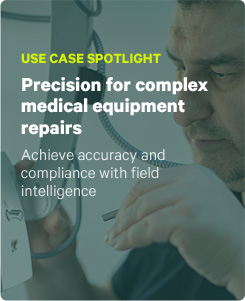
The world of field service is changing. A new generation of technologies and asset management software is transforming heavy industry into advanced manufacturing entities of the future. But there are forces bearing down on that future. What are they? According to 100+ field service leaders surveyed for Service Council’s 2020 Service Leader’s Agenda Survey, these are the top four challenges weighing heavily on organizations in 2020. Each of these challenges reflect larger macro trends that have serious competitive implications. What are they and how can you prepare for them.
1. Changing customer expectations is cited by 77% of heavy manufacturing executives as the biggest concern facing their organizations.
The shift to outcome-based service is widespread. Heavy manufacturing organizations involved in aftermarket services are not immune to rising expectations for easy access to information and quick, transparent service. Nor are they exempt from the customer expectation that high-value and high-risk assets — like MRI machines or commercial HVAC systems — shouldn’t be subjected to asset downtime, period. Customers need service that predicts and solves issues before they even occur. After all, estimates peg unplanned downtime as a conservative $260,000 an hour for many organizations. How do you meet expectations to provide guaranteed uptime and outcome-based SLAs? Many organizations turn to technology to provide more sophisticated forms of service.
2. The evolution of technology has 50% of heavy manufacturing leaders sitting on the edge of their seats.
With new technological advances launching every 18 months or so, where is automation investment best spent? Artificial intelligence, IoT, and machine learning bring a clearer understanding of operations and provide predictive maintenance insights. Paired with guided workflows they can be a solution to providing outcome-based service.
To combat lost productivity, heavy manufacturers are turning to tools like asset inventory software, asset tracking, safety management and HVAC applications to improve efficiencies and aftermarket service. The best of the best data-driven computing integrates operations and asset management software with existing enterprise systems. The tools are intuitive and easy to learn. They’re cloud-based so your workers can access or input information from anywhere — with or without a network connection. And submission dashboards, or basic analytics, provide real-time at-a-glance views of what’s happening across your organization.
Forecasts suggest by 2021, 20% of G2000 manufacturers will have moved to an intelligent manufacturing model. Are your operations ready to compete?

3. Workforce and talent shortages are on the radar of 72% of heavy manufacturing leaders. And for good reason.
As Baby Boomers retire, heavy manufacturing organizations face a widening skill gap between different tenured employees due to the loss of seasoned workers with experience and institutional knowledge and the retention of younger workers that have increasingly high turnover.
These same new Millennial and Gen Z technicians have grown up with technology and expect to find it in their places of work.
The heavy manufacturer leaders of today and tomorrow need workers trained in IoT, AI, and sophisticated asset workflows. Automation specialists with highly sought-after skill sets are already scarce. Fierce competition for this talent pool will only intensify. LinkedIn found the most in-demand skills in 2019 were in technical skill categories like cloud computing, artificial intelligence and analytical reasoning, thanks to the evolution of technology in field service.
4. Increasing competition is the fourth macro trend cited by 23% of heavy manufacturer leaders.
The pressure to automate is high. Labor pools are strained and under-skilled. Industry customers are demanding better transparency and personalized service. Like it or not, these long-term forces will track across the entire supply chain, of which your organization is part of.
For those who jump on the digital technology bandwagon, efficiencies will make it easier to expand offerings. What that means is companies that aren’t on your competitor radar today, may be your biggest rival tomorrow (think traditional automotive makers and Google’s pioneering self-driving car technology).
According to McCoy Consulting, “Even if your market is stable, disruptions in other markets can drive competitors into your space.” This is seen even in the heavy manufacturing industry as more OEMs push to include aftermarket services in their offerings — completely skipping the middle man.
Asset Management Software unlocks the future
What can a heavy manufacturing company do? It’s easy to feel stuck. Only 50% of heavy industry and manufacturing companies have a proactive or outcome-based service delivery model. The rest react to issues and struggle to manage operational processes. Bottlenecks and workflows impede agility and responsiveness to customer needs. What’s stopping the remaining 50%?
Fortunately, the rise of low-code application platforms (LCAPs) has made the transition towards digital transformation effective and economical.
An LCAP vigilantly tracks technician input throughout a workflow, uncover patterns and trends, and set the stage for predictive preventative management and workflows.
Data integrates across your entire organization from back-office staff to technicians out in the field, and from personal mobile devices to your company’s existing record and cloud systems.
Data is accessed in real-time from the office or the field. Insights from an LCAP tool can be shared, in real-time, with any number of internal stakeholders, and feature the ability to generate accurate, transparent reports for customers and regulatory bodies.
The importance of mastering field data is reiterated by IndustryWeek’s “Building Apps in the Wild.” “To survive within this fast-paced environment, field representatives need to be able to leverage and manipulate the mountains of data coming from deployed equipment.”
Conclusion
Those industrial macro trends cresting on the horizon are as real as the technology that’s helping others meet the future with confidence and competitive agility. Isn’t it time for your organization to step into the future too?
If you’re interested in learning more about the future of field service, join Buddy Saucier, VP, HVAC & Controls Service at Johnson Controls, Service Council, and Mark Scott, VP of Marketing at ProntoForms on Tuesday, February 25, 2020, at 11 AM CT for a webinar where they discuss the macrotrends shaping the future of field service and how innovative leaders are tackling them. Space is limited!



